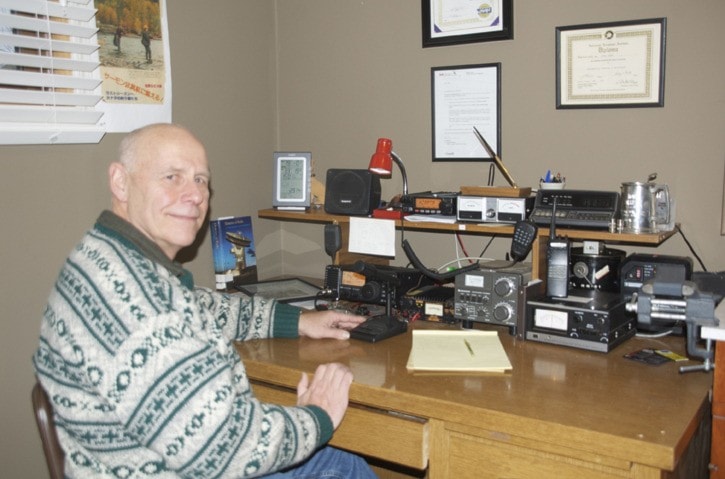Once, in a time before cell phones, Bob Haslett and his family were driving the highway near Jasper in the early evening when his truck suffered a mechanical break down.
A good distance from anywhere, he had only two options: wave his arms in the air to anyone who passed by, or get on his ham radio and do a general call out.
Being an amateur radio operator since 1964, the broadcast seemed the logical step to take. Nearby, a trucker was heading through the area and heard Haslett’s call. The driver immediately turned around and brought them into Jasper.
Such is the bond of ham radio operators. When was the last time your Facebook friends did that for you?
Haslett is the president of the Bulkley Valley Amateur Radio Society, a close group of people who share a passion for the airwaves.
About four years ago they formed the society which has since received two government gaming grants of over $8,000 each.
Radio would be the valley’s line of communication if something really bad happens. In other disasters, such as New Orleans’ flooding or Haiti’s earthquake, radio was the primary means of communication. In Smithers they can be at the Ranger Park building at a moment’s notice, set up and broadcasting.
“With those repeaters and links we can link up Hazelton to Smithers, Smithers to Houston, Houston to Burns Lake,” said Haslett. The network can even extend as far as Vancouver Island.
“What we’re trying to do in our own small way is have a prepared emergency operations centre in conjunction with the town so in times of need we would have a completely independent communication system.”
In other words, in times of trouble it would be radio, and not your cell phone, that reaches anybody.
The technology behind radio broadcasting is interesting if, as Haslett explained, not quite as mystical as it once was. Depending on the kind of frequency you broadcast, your signal can reach Hazelton or, perhaps, New Zealand.
“You can bounce a signal off a mountain and we bounce one from here off a mountain in the Bulkley Valley to a repeater up in Hazelton,” he said.
For different frequencies, “depending on where the ionospheric layer is at any given time will determine the angle your signal bounces. So one minute you may be talking to Mexico and the next minute you’re around to New Zealand or Australia.”
They can also use the Internet to reach repeaters in other parts of the world, that are connected by just four digits, just like dialing a phone.
When he first became involved in radio there were different qualifications to get a licence. When he got his, he had to know morse code and essentially how to build a station from scratch.
He said his first radio was completely home built.
“Now you can’t build things cheaper than you can buy it,” he said.
The society now has about two dozen members, and over the years has had as many as 40. He said that, per capita, the club is doing about as well as any other club in B.C. at the moment.
That being the case, they are willing to take on people who are interested in radio training.
Their website is http://www.pgarc.org/BVARS.html and contains their newsletters and a contact e-mail.
